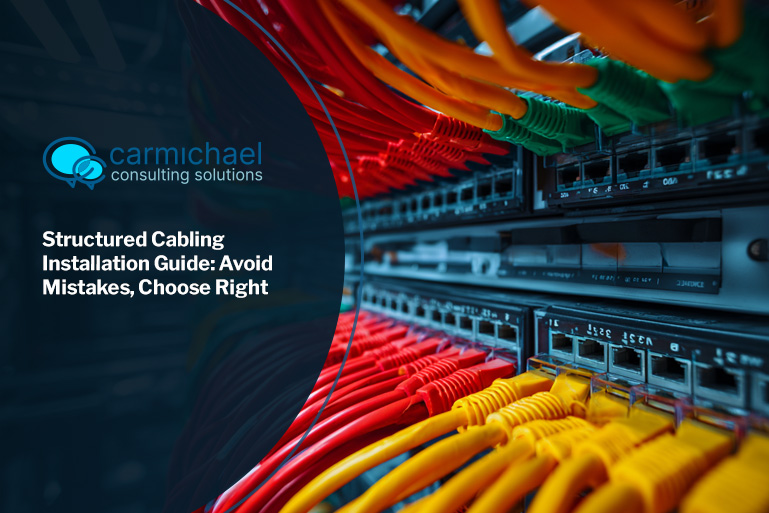
A reliable, structured cabling installation is the foundation of any modern business network. Whether you're expanding your office or upgrading outdated systems, the right setup ensures faster data transmission, fewer disruptions, and easier maintenance. In this guide, you'll learn what structured cabling is, how to install it properly, and how to choose the right installer for your needs. We'll also cover key components, common mistakes, and practical tips to help you get the most from your investment.
[.c-button-wrap2][.c-button-main2][.c-button-icon-content2]Contact Us[.c-button-icon2][.c-button-icon2][.c-button-icon-content2][.c-button-main2][.c-button-wrap2]
Structured cabling installation refers to the organized method of setting up a building's cabling infrastructure. It supports multiple hardware systems and is designed to handle everything from voice and data to video and security systems. Unlike point-to-point wiring, structured cabling follows a standardized approach that makes it easier to manage and scale.
A well-designed structured cabling system helps reduce downtime, improves network performance, and simplify future upgrades. It also ensures compliance with industry standards and supports high-speed data transfer. Whether you're setting up a new office or upgrading an existing one, structured cabling is a long-term investment in your network infrastructure.

Even small errors in structured cabling installation can lead to major problems down the line. Here are some key steps to follow to avoid common pitfalls.
Start with a detailed layout of your office space, including where devices, workstations, and equipment will be located. This helps you map out the best cable routes and avoid future rework.
Different applications require different cables. For example, fiber optic cabling is ideal for long distances and high-speed data, while Cat6 is great for shorter runs. Choosing the wrong type can limit performance.
Always plan for expansion. Leave extra capacity in your cabling infrastructure so you can add more devices or upgrade systems without starting from scratch.
Adhering to standards like ANSI/TIA-568 ensures your system is compatible with current and future technologies. It also helps with troubleshooting and maintenance.
Proper labeling of cables, ports, and panels saves time and reduces confusion when making changes or fixing issues. It’s a small step that makes a big difference.
Keep cables away from power lines, fluorescent lights, and other sources of interference. This helps maintain signal quality and reduces data transmission errors.
A qualified installer knows how to design and implement a system that meets your needs. They’ll also ensure compliance with safety and performance standards.
Structured cabling offers several advantages for businesses of all sizes:

The success of your structured cabling installation depends heavily on the installer you choose. A skilled professional will assess your current and future needs, recommend the right components, and ensure everything is installed correctly.
Inexperienced installers may cut corners, use substandard materials, or ignore industry standards. This can lead to frequent outages, poor data transfer speeds, and costly repairs. Always check credentials, ask for references, and make sure your installer is familiar with both horizontal and backbone cabling requirements.
A structured cabling system is made up of several essential parts. Each one plays a role in supporting your network’s performance and reliability.
This connects individual workstations to the telecommunications room. It typically includes cables, patch panels, and outlets.
Also known as vertical cabling, this links different floors or sections of a building. It handles large volumes of data and connects main distribution areas.
Patch panels organize and connect incoming and outgoing cables. They make it easier to manage and troubleshoot your network.
These are centralized spaces where network equipment is housed. They serve as connection points for horizontal and backbone cabling.
These include the cables and connectors that link user devices to the network. They must be compatible with the rest of the system.
This is where external service provider cables enter your building. It includes grounding and surge protection equipment.

Before you install structured cabling, take the time to evaluate your space, equipment, and business goals. Think about how many users you have, what types of devices you use, and how your needs might grow in the next few years.
Use high-quality materials and follow structured cabling standards to ensure long-term reliability. Make sure your installer tests every connection and provides documentation for future reference. If you're working in a data center or high-density environment, consider using cable management systems to keep everything organized.
To get the most out of your structured cabling investment, follow these proven practices:
Following these steps helps ensure a smooth installation and a reliable network.

Are you a business with 10 to 350 employees looking for a better way to manage your network? If you're growing fast and need a structured cabling solution that can keep up, we’re here to help. Our team designs and installs systems that support your current needs and future growth.
At Carmichael Consulting Solutions, we understand how critical reliable cabling is to your business operations. We’ll help you choose the right structured cabling system, install it properly, and ensure it meets all performance standards. Contact us today to get started.
[.c-button-wrap2][.c-button-main2][.c-button-icon-content2]Contact Us[.c-button-icon2][.c-button-icon2][.c-button-icon-content2][.c-button-main2][.c-button-wrap2]
Structured cabling uses a standardized approach to organize your cabling infrastructure. Traditional setups often rely on point-to-point wiring, which can become messy and hard to manage. Structured cabling supports better data transmission and easier upgrades.
It also improves network infrastructure by reducing clutter and making maintenance simpler. This is especially important in environments with high-speed data needs or multiple devices.
If your business is growing or you’re experiencing frequent network issues, it may be time to consider structured cabling services. These services help streamline your network and prepare it for future expansion.
They also ensure your cabling infrastructure supports modern technologies like VoIP, cloud computing, and video conferencing. A professional assessment can help you decide.
Look for an installer with experience, certifications, and a clear understanding of structured cabling standards. They should also provide documentation and testing results.
A good installer will help you choose the right cable type and design a system that meets both current and future needs. Don’t be afraid to ask for references.
The timeline depends on the size of your space and the complexity of your network. A small office might take a few days, while larger projects could take weeks.
Planning ahead and working with experienced structured cabling installers can help avoid delays. Make sure your installer provides a clear schedule.
Key components include horizontal cabling, backbone cabling, patch panels, telecommunications rooms, and entrance facilities. Each plays a role in your network’s performance.
Understanding these components helps you make better decisions during installation. It also makes troubleshooting easier if problems arise.
Start by reviewing your current network setup and future needs. Identify where devices will be located and how much bandwidth you’ll need.
Then, work with a professional to design a structured wiring plan that fits your space. Proper planning ensures a smoother installation and better long-term results.
